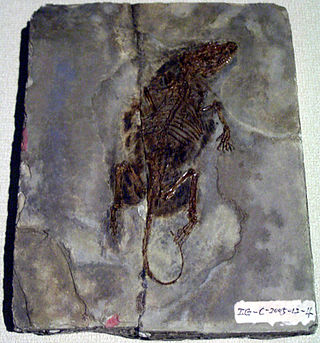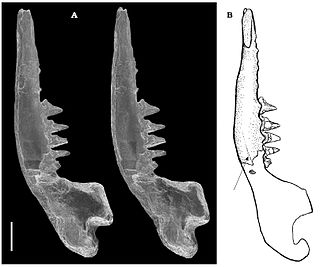The Isle of Wight is one of the richest dinosaur localities in Europe, with over 20 species of dinosaur having been recognised from the early Cretaceous Period, some of which were first identified on the island, as well as the contemporary non-dinosaurian species of crocodile, turtle and pterosaur.

Caulkicephalus is a genus of anhanguerid pterosaur from the Isle of Wight off the coast of England. It lived during the Early Cretaceous period, about 130 million years ago.

Eotyrannus is a genus of tyrannosauroid theropod dinosaur hailing from the Early Cretaceous Wessex Formation beds, included in Wealden Group, located in the southwest coast of the Isle of Wight, United Kingdom. The remains (MIWG1997.550), consisting of assorted skull, axial skeleton and appendicular skeleton elements, from a juvenile or subadult, found in a plant debris clay bed, were described by Hutt et al. in early 2001. The etymology of the generic name refers to the animal's classification as an early tyrannosaur or "tyrant lizard", while the specific name honors the discoverer of the fossil.

Symmetrodonta is a group of Mesozoic mammals and mammal-like synapsids characterized by the triangular aspect of the molars when viewed from above, and the absence of a well-developed talonid. The traditional group of 'symmetrodonts' ranges in age from the latest Triassic to the Late Cretaceous, but most research in the last 20-30 years has concluded that they are not a true taxonomic group, but include several unrelated branches of the mammal tree. Despite this, the name is still used informally by some researchers for convenience, usually restricted to the spalacotheriids and zhangheotheriids.

Akidolestes is an extinct genus of mammals of the family Spalacotheriidae, a group of mammals related to therians.

Yaverlandia is a genus of maniraptoran dinosaur. Known from a partial fossil skull found in Lower Cretaceous strata of the Wessex Formation on the Isle of Wight. it was described as the earliest known member of the pachycephalosaurid family, but research by Darren Naish shows it to have actually been a theropod, seemingly a maniraptoran. The type species is Y. bitholus.

Dromaeosauroides is a genus of dromaeosaurid theropod dinosaur from the Early Cretaceous of what is now Denmark and possibly also England. It was discovered in the Jydegaard Formation in the Robbedale valley, on the island of Bornholm in the Baltic Sea. This is the only likely place for dinosaur remains to be discovered on Danish territory, since the Mesozoic deposits exposed in the rest of the country are marine. Dromaeosauroides is the first known dinosaur from Denmark, and the only one which has been scientifically named. It is one of the oldest known dromaeosaurs in the world, and the first known uncontested dromaeosaur from the Early Cretaceous of Europe.

Yaverland is a village and former civil parish, now in the parish of Sandown, on the Isle of Wight, England. It is just north of Sandown on Sandown Bay. It has about 200 houses. About 1⁄3 of a mile away from the village is the Yaverland Manor and Church. Holotype fossils have been discovered here of Yaverlandia and a pterosaur, Caulkicephalus. The White Air extreme sports festival was held annually at Yaverland pay and display car park between 1997 and 2008, but moved to Brighton for 2009.

Mantellisaurus is a genus of iguanodontian dinosaur that lived in the Barremian and early Aptian ages of the Early Cretaceous Period of Europe. Its remains are known from Belgium (Bernissart), England, Spain and Germany. The type and only species is M. atherfieldensis. Formerly known as Iguanodon atherfieldensis, the new genus Mantellisaurus was erected for the species by Gregory Paul in 2007. According to Paul, Mantellisaurus was more lightly built than Iguanodon and more closely related to Ouranosaurus, making Iguanodon in its traditional sense paraphyletic. It is known from many complete and almost complete skeletons. The genus name honours Gideon Mantell, the discoverer of Iguanodon.
Galve is a municipality located in the province of Teruel, Aragon, Spain. According to the 2006 census (INE), the municipality has a population of 145 inhabitants. There is an important paleontological site.

Dryolestida is an extinct order of mammals, known from the Jurassic and Cretaceous. They are considered basal members of the clade Cladotheria, close to the ancestry of therian mammals. It is also believed that they developed a fully mammalian jaw and also had the three middle ear bones. Most members of the group, as with most Mesozoic mammals, are only known from fragmentary tooth and jaw remains.

The Wessex Formation is a fossil-rich English geological formation that dates from the Berriasian to Barremian stages of the Early Cretaceous. It forms part of the Wealden Group and underlies the younger Vectis Formation and overlies the Durlston Formation. The dominant lithology of this unit is mudstone with some interbedded sandstones. It is part of the strata of the Wessex Basin, exposed in both the Isle of Purbeck and the Isle of Wight. While the Purbeck sections are largely barren of vertebrate remains, the Isle of Wight sections are well known for producing the richest and most diverse fauna in Early Cretaceous Europe.

The Kitadani Formation is a unit of Lower Cretaceous sedimentary rock which crops out near the city of Katsuyama in Fukui Prefecture, Japan, and it is the primary source of Cretaceous-aged non-marine vertebrate fossils in Japan. Dinosaur remains are among the fossils that have been recovered from the formation, but it also preserves a diverse assemblage of plants, invertebrates, and other vertebrates. Most, if not all, of the fossil specimens collected from the Kitadani Formation are reposited at the Fukui Prefectural Dinosaur Museum.

Barilium is a genus of iguanodontian dinosaur which was first described as a species of Iguanodon by Richard Lydekker in 1888, the specific epithet honouring the discoverer Charles Dawson, who collected the holotype during the 1880s.

Wesserpeton is an extinct genus of albanerpetontid amphibian known from the Isle of Wight, southern England.

Vectidraco, is a genus of azhdarchoid pterosaur from the Lower Cretaceous of England.

Spalacotheriidae is a family of extinct mammals belonging to the paraphyletic group 'Symmetrodonta'. They lasted from the Early Cretaceous to the Campanian in North America, Europe, Asia and North Africa.

Meridiolestida is an extinct clade of mammals known from the Cretaceous and Cenozoic of South America and possibly Antarctica. They represented the dominant group of mammals in South America during the Late Cretaceous. Meridiolestidans were morphologically diverse, containing both small insectivores such as the "sabretooth-squirrel" Cronopio, as well as the clade Mesungulatoidea/Mesungulatomorpha, which ranged in size from the shrew-sized Reigitherium to the dog-sized Peligrotherium. Mesungulatoideans had highly modified dentition with bunodont teeth, and were likely herbivores/omnivores. Meridiolestidans are generally classified within Cladotheria, more closely related to living marsupials and placental mammals (Theria) than to monotremes, barring one study recovering them as the sister taxa to spalacotheriid "symmetrodonts". However, more recent studies have stuck to the cladotherian interpretation. Within Cladotheria, they have often been placed in a group called Dryolestoidea together with Dryolestida, a group of mammals primarily known from the Jurassic and Early Cretaceous of the Northern Hemisphere. However, some analyses have found this group to be paraphyletic, with the meridiolestidans being more or less closely related to therian mammals than dryolestidans are. Meridiolestidans differ from dryolestidans in the absence of a parastylar hook on the molariform teeth and the lack of a Meckelian groove.

Symmetrolestes is an extinct genus of small spalacotheriid mammal from the Early Cretaceous period of Japan. The genus contains one species known as S. parvus, the type fossil is from fluvial deposits located in the Dinosaur Quarry in the Kitadani Formation, near the city of Katsuyama which lies alongside valley of the Sugiyamagawa River. It was described by Tsubamoto and Rougier in 2004. The holotype is kept at the National Science Museum, Tokyo, Japan.
Wightia is a genus of tapejarid pterosaur recovered from the Lower Cretaceous (Barremian) aged Wessex Formation of the Isle of Wight of England, from which it gets its name. The only species within this genus is W. declivirostris.






















